
Produced as a mock-up visualisation, the HP Scitex FB colour Pack provides the ability to add Orange and Light Black. When printing for companies using orange in their corporate or brand colour, this capability can be a powerful differentiator
Broader, brighter, better
‘What a difference a day makes’. So the old song goes, if you are old enough to remember it. In sign-making it would read: ‘what a difference an ink makes’. And none more so than the vast and fast-developing range of speciality inks now on offer. Not just glitter, metallics, and a wider choice of colours, but varnish inks, UV cure, and dye-sublimation options, all designed to enable the production of creative and eye-catching end-products, often with greater speed than ever before.
Colour, shine, and a fast finish
As one of the companies at the fore-front of ink design and research, HP is constantly seeking to develop new products to help sign-makers and digital print-service-providers (PSPs) grow their business and explore new markets.
Two such products introduced in the last twelve months are HP FB225 Scitex Varnish ink, which was added to the HP Scitex FB7500/FB7600 Enhanced Color Pack, and the HP Scitex FB7600 Colour Pack. The new FB225 Scitex Varnish ink allows HP Scitex FB7500/FB7600 industrial press owners to add spot or full varnish, create embossed text and images, as well as expand the colour gamut by 18.6 percent according to HP internal testing.
Simon Goldsack, marketing development manager at HP Scitex, comments: “The Scitex Varnish Ink offers a unique option to customers, such as the ability to enhance the effect by printing up to five layers of varnish onto designs for point-of-sale (POS) and packaging manufacturers to create an embossed 3D effect.”
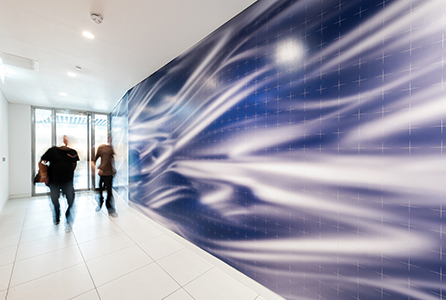
The stunning silver, white, and blue interior wall and glass graphics for the new Rolls-Royce Derby visitor reception interior, printed by Limited Ltd on the Epson SureColour SC-S70600
The Scitex FB7600’s colour pack also provides the ability to add two new colours, orange and light black, to the six-colour set of HP Scitex FB7600 Industrial Presses and upgraded HP Scitex FB7500s. These additional colours can be installed together or added incrementally. The new orange ink gives a gamut volume increase of 10 percent with a Pantone colour coverage increase of six percent and an overall ability to achieve 7 percent more corporate colours.
“When printing for companies using orange in their corporate or brand colour, this capability can be a powerful differentiator,” Goldsack points out.
Roland DG says that its ECO-SOL MAX ink, which includes white and metallic, and ECO-UV, which includes white and gloss inks, are fundamental components in its ability to offer an ever increasing range of high-value, highly-profitable applications to customers.
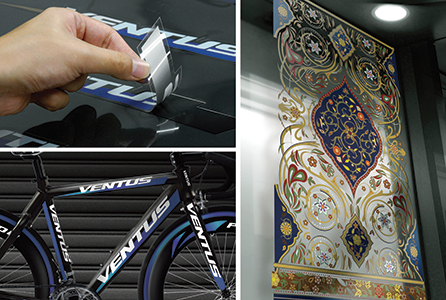
Roland’s new white and metallic ECO-SOL MAX inks create graphics that really stand out
Rob Goleniowski, business manager, signs and graphics at Roland DG explains: “Printing with white ink ensures the sign-maker can offer high opacity graphics, while metallic ink will deliver more dynamic, eye-catching, and unique products that give customers a real point of difference against the competition.”
The Roland Metallic Colour Library offers 512 metallic combinations and its Metallic Texture Library has 26 unique visual texture fills.
Goleniowski adds: “All these inks offer outstanding durability, making them suitable for the broadest range of outdoor and indoor applications.”
O Factoid: Many ancient cultures around the world have independently discovered and formulated inks for the purposes of writing and drawing. The history of Chinese inks can be traced back to the 23rd century BC, with the utilisation of natural plant (plant dyes), animal, and mineral inks based on such materials as graphite that were ground with water and applied with ink brushes. O
Mimaki has recently released the Mimaki SUV that uses a solvent/UV hybrid ink to deliver a glossy, hard wearing, and instantly dry finish, which is a significant advantage for sign-makers.
John de la Roche, national sale manager of UK distributor Hybrid Services, comments: “It means that they’re able to print on demand and trim, cut, or finish immediately as it comes off the printer. Prints don’t always require lamination, but even that can be carried out straight away too.”
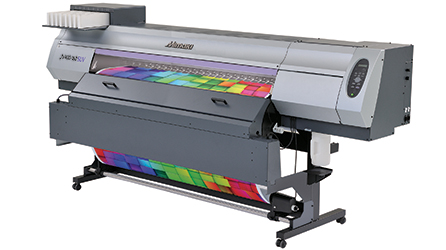
The Mimaki JV 400-SUV uses a solvent/UV hybrid ink to deliver a glossy, hard wearing and instantly dry finish, which is a significant advantage for sign-makers
Wakefield-based Hippoprint was the first print company in the UK to install a 1.6m JV400-SUV. Company owner Anthony Wood comments: “It means that we stay at the forefront of the rapid turnround sector. We need the capability to instantly finish prints and get them to our customers the next day. We frequently supply highcolour posters and pull-up banners with large ink loads, but it can be a real challenge to finish them the same day as they’re printed. The SUV means we can print and send within a matter of minutes, and with 95 percent of our orders coming late in the day, it takes a little bit of the pressure off.”
Taking the cure
Another of Mimaki’s significant strengths is its innovative range of flatbed LED UV printers. Products such as the A3 format UJF-3042HG and flatbed A2 UJF-6042 model have a wide variety of inks, including highly-flexible direct-to-substrate. The LED UV cure sets feature bright, opaque white, clear varnish, and digitally prinable primer, as well as vibrant colours.
Hybrid Services’ de la Roche explains: “This opens up lots of new avenues for printing small-format rigid signage direct-to-substrate, or any number of promotional products and gifts direct to the product.”
Fujifilm has recently launched a new thermo forming UV-cured inkjet ink, Uvijet KV, aimed at light industrial applications. The company’s heritage in screen printing ink, and as a pioneer of wide-format digital UV inkjet ink, enabled Fujifilm to develop Uvijet KV. This new ink system has been designed specifically for use with the company’s mid-range flatbed printers, the Acuity Advance Select and Acuity Advance Select HS.
The new formulation maintains the high quality, vivid colours, and perfo-rmance associated with Fujifilm ink, with no compromise to the print speed. Once the printing of a flat plastic sheet is completed, it is removed to a mould where it is heated up to take on the shape of the mould, and then cooled. The ink has elongation properties of 300 or 400 percent when heated, returning to a ‘normal’ state when cool.
Mike Battersby, marketing manager for large-format at Fujifilm Speciality Ink Systems, comments: “The Acuity is a platform that has become established as the industry benchmark for print quality in its category, and now with the addition of Uvijet KV to the ink range, we are able to help our customers take advantage of profitable new applications.
“Large-format printing has for some time been expanding away from the ‘traditional’ graphics markets, so we’ve been using our extensive ink and application knowledge to develop solutions that allow these systems to be used for different light industrial applications. The use of inkjet printing in thermo forming is not well established, but there is an opportunity for early adopters to use their creativity and innovation to open up and develop exciting new markets.
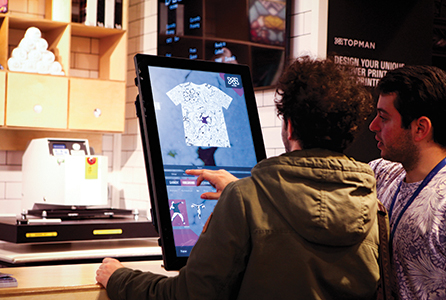
(Above and below) On-demand printing: a customer in Topman creates a one-off pattern
in-store using an interactive touch-pods. Designs are then instantly printed
on the Epson SureColour SC-F6000 dye-sub printer
“Uvijet KV ink is extremely flexible, so that it can heat and cool without cracking or flaking. Other UV-cured digital inks simply would not be able to achieve this level of flexibility. Thermo forming is an increasingly popular process in industrial applications, with a variety of plastics being used. Typical substrates that could be printed include polystyrene and PETG, both of which mould easily into new shapes when hot. We are very excited about the new ink, as it opens up new business opportunities for our prospects and customers.”
A soft touch
Mimaki has a great heritage in textile printing, so the current boom in soft signage comes as no surprise to the company, which has been heavily involved in the growth of the sector for many years.
De la Roche of Hybrid Services continues: “An aqueous, dye-sublimation print to polyester delivers a res-ult with no ‘handle’ (it doesn’t alter the feel of the fabric when it’s printed) and the colours and light fastness are superb. And for indoor and outdoor displays that are easy to install, transport, and maintain, a textile print offers significant benefits.”

Epson has really succeeded with its ink and its understanding of CMYK and the gamuts that go with that”
Mimaki’s range of dye-sublimation printers start from models requiring as little investment as £10,000 and go right up to 3.2m-wide industrial machines that are found in the largest printing companies, delivering grand-format work for the retail, exhibition, and building wrap markets.
De la Roches adds: “The UK and Irish manufacturing of fashion and sportswear is a big growth market too (using the same inks and similar printers) and it’s allowing retailers to supply products in shorter, more exclusive runs that arrive in the shops quicker and with a known quality. Manufacturing is slowly starting to come home.”
Epson has also entered the dye-sublimation and direct-to-garment (DTG) textile printing market, with the SureColor SC-F6000 and 7000 dye-sub printers and the SureColor SC-F2000 direct-to-garment printer. The dye-sub printers use Epson UltraChrome DS aqueous ink, which the company says gives vibrant colours, sharp contours, and smooth gradations with excellent light and wash-fastness, plus abrasion and perspiration resistance.
The DTG printer uses Epson’s UltraChrome DG ink, an eco-friendly formulation that has been awarded part certification from Oeko-Tex Standard 100. This means it does not contain harmful substances when printed onto a textile. Epson textile inks are also crease and crack resistant, and are soft on the skin, making them ideal for clothing applications.
When printing firm T Shirt and Sons was chosen to put Epson’s new SureColor SC-F2000 direct-to-garment printer through its paces they were hugely impressed.
Based in Westbury, Wiltshire, the company produces high-quality printed and embroidered promotional clothing and accessories for a broad range of high-profile clients, specialising in t-shirts and cotton bags made from Fairtrade and organic certified cotton. Digital printing is a relatively new venture for T Shirt and Sons, and adding another string to its bow means that it can now produce short print runs quickly, and at the exact time they are needed, something it was not able to do previously.
Andy Lunt, managing director of T Shirt and Sons, comments: “With digital every t-shirt can be different. For example, we can have one design printed on six different sizes of shirt, which wasn’t feasible with screen printing as every shirt would have to be set up individually, a long and costly process.”
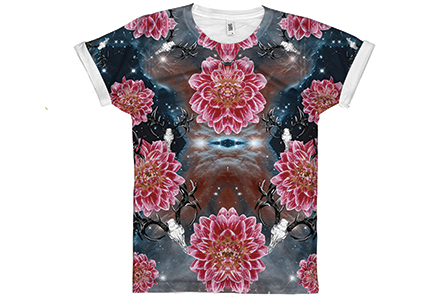
The finished t-shirt: printed on-site using the Epson SC-F6000 and ready-to-go within minutes
Lunt continues: “We’ve worked the printer pretty hard. We’ve done all the things we shouldn’t do and it’s continued to work beautifully. The quality of print and colour brightness are very impressive, by far the best I’ve seen from any textile desktop printer, but then Epson has had quite a few years of experience in this.
“Epson has really succeeded with its ink and its understanding of CMYK and the gamuts that go with that. The quality of colour is so much better than any other ink system and the brightness is second to none. I can honestly say that the quality is as bright as a screen print, which is unusual for a digital print. The print feels soft and doesn’t crack; in fact, you’ll probably find that the shirt falls apart or you get fed up with the design before the print comes off.”

It is ink development, and the recent growth in the range of speciality inks in particular, that has been the driving force behind wide-format’s increasing flexibility”
With an ever increasing range of innovative inks now available, opportunities for sign-makers and PSPs to develop new offerings for their customers are constantly presenting themselves. Whether it be a totally new line of services or simply a much faster turnaround, what could give you the edge over your competitors?
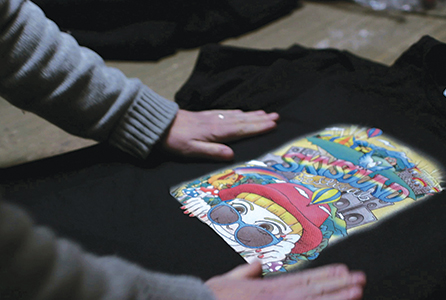
This t-shirt was printed using Epson’s SureColor SC-F2000 and its UltraChrome DG inks
Roland DG’s Goleniowski summarises: “In many ways it is ink development, and the recent growth in the range of speciality inks in particular, that has been the driving force behind wide-format’s increasing flexibility and the opening up of exciting, new high-growth and profitable markets for sign-makers. The burgeoning textile, soft signage, and packaging prototyping sectors are great examples of this. This is also reflected in the more traditional areas of the market, where inks such as white, metallic, and gloss are bringing new life, creativity, and excitement to the banner, POS, labels, wall and window graphics, and car wrapping sectors.”
hhhhhhhhh